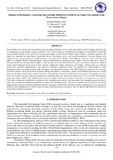| dc.description.abstract | Poor health service delivery has been linked to the devolution of health services, with some health workers walking off the job due to inadequate pay and unsafe working conditions. This research aimed at establishing the influence of participative leadership style on public health service delivery by county governments in the Western Kenya region. Taking a positivist approach, the study was anchored on participative leadership theory. Descriptive survey and causal-comparative research designs were adopted with a target population of 966 personnel consisting of the CECMs, Chief Officers, Directors, and County Nursing Officer for Health, Medical Superintendents, Hospital Administrator, Human Resource Officer, Head of Pharmacy, Head of Nursing, Health Records Information Officer, Head of Laboratory, Head of Clinical Services and number of patients admitted, treated and discharged drawn from all four counties of Bungoma, Busia, Kakamega, and Vihiga. Primary data was collected using both structured questionnaires and interview schedules. Qualitative data was analysed by content analysis while quantitative data was analysed using both descriptive and inferential statistics. The SPSS Software version 26 was used for statistical analysis which was both descriptive whereby frequencies, percentages, means, and standard deviation were clearly shown in the form of both tables, models and charts. The hypothesis tested for significance of the study at 5% significance level. From the results, the beta value for participative leadership from the regression model was 0.777 at p<0.05. Participative leadership explains 60.4% (R2 =0.604) of the variance in public health service delivery. Therefore, the hypothesis was rejected. The study recommends establishing transparent and straightforward policies and procedures for managing human resources, which are essential for promoting productivity, equity, and workplace peace. In order to improve service delivery, the report suggests that county governments implement methods to promote collaborative decision-making. Consultation is a necessary part of the decision making process. In this regard, as many of the perspectives of workers who are directly affected by the decision as are feasible should be considered. | en_US |

